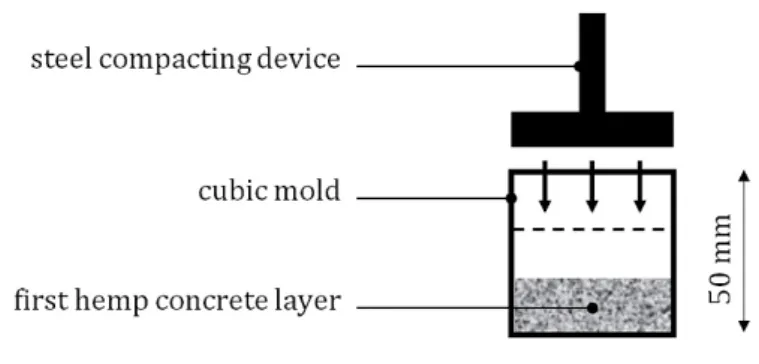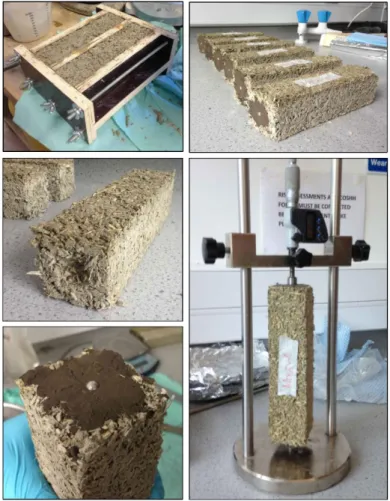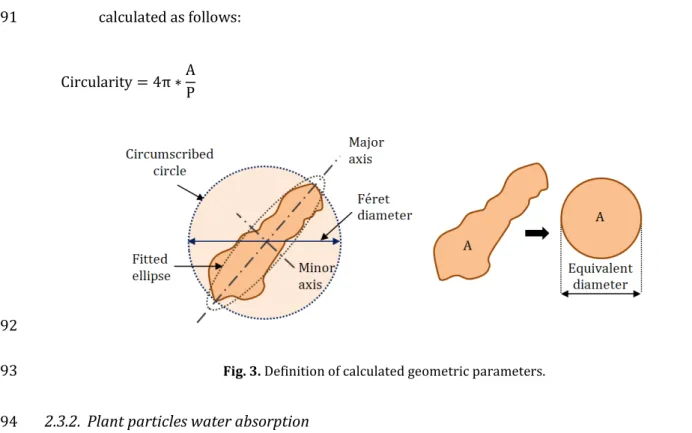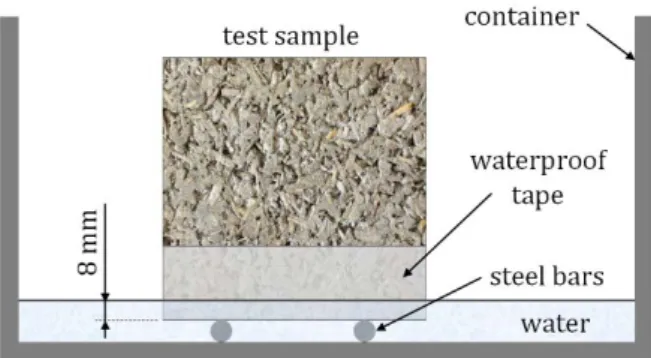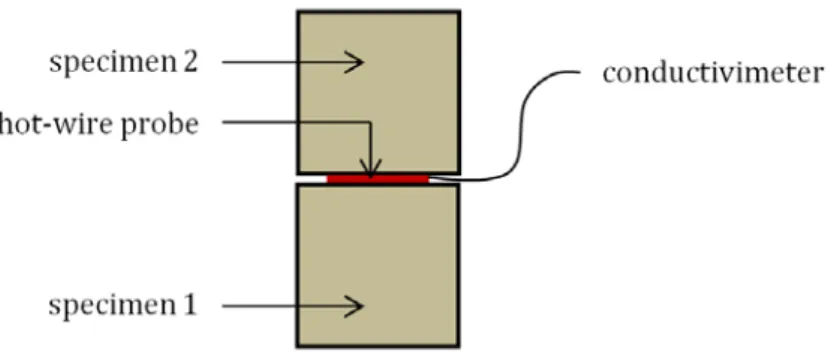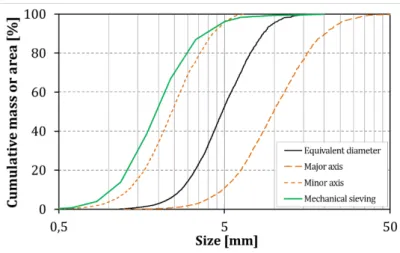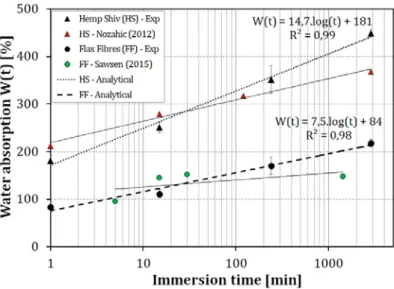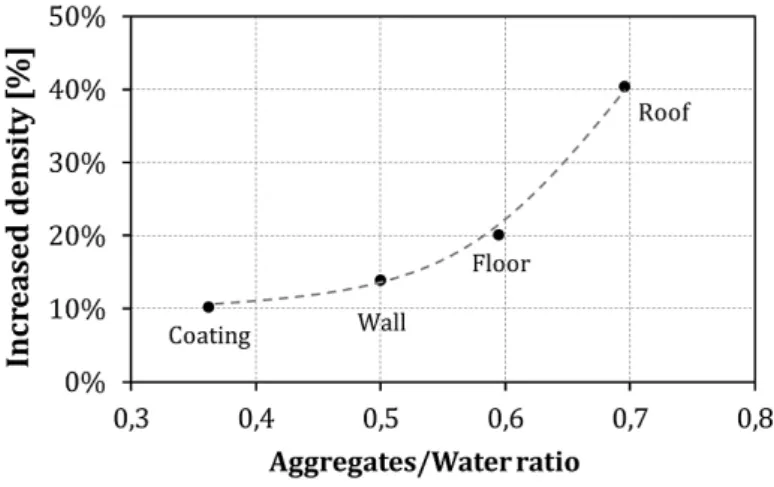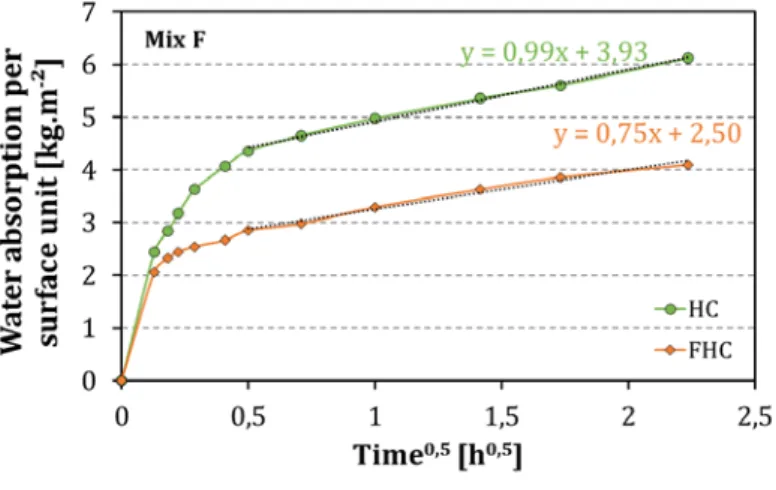HAL Id: hal-01652368
https://hal.archives-ouvertes.fr/hal-01652368
Submitted on 28 Feb 2019HAL is a multi-disciplinary open access archive for the deposit and dissemination of sci-entific research documents, whether they are pub-lished or not. The documents may come from teaching and research institutions in France or abroad, or from public or private research centers.
L’archive ouverte pluridisciplinaire HAL, est destinée au dépôt et à la diffusion de documents scientifiques de niveau recherche, publiés ou non, émanant des établissements d’enseignement et de recherche français ou étrangers, des laboratoires publics ou privés.
Distributed under a Creative Commons Attribution - NonCommercial| 4.0 International License
Design and multi-physical properties of a new hybrid
hemp-flax composite material
J. Page, M. Sonebi, Sofiane Amziane
To cite this version:
J. Page, M. Sonebi, Sofiane Amziane. Design and multi-physical properties of a new hybrid hemp-flax composite material. Construction and Building Materials, Elsevier, 2017, 139, pp.502 - 512. �10.1016/j.conbuildmat.2016.12.037�. �hal-01652368�
Design and multi-physical properties of a new hybrid hemp-flax
composite material
Page, J., Sonebi, M., & Amziane, S. (2017). Design and multi-physical properties of a new hybrid hemp-flax composite material. Construction and Building Materials, 139, 502-512. [1].
https://doi.org/10.1016/j.conbuildmat.2016.12.037
Published in:
Construction and Building Materials
Document Version: Peer reviewed version
Queen's University Belfast - Research Portal:
Link to publication record in Queen's University Belfast Research Portal
Publisher rights
© 2016 Elsevier Ltd. This manuscript version is made available under the CC-BY-NC-ND 4.0 license http://creativecommons.org/licenses/by-nc-nd/4.0/ which permits distribution and reproduction for non-commercial purposes, provided the author and source are cited.
General rights
Copyright for the publications made accessible via the Queen's University Belfast Research Portal is retained by the author(s) and / or other copyright owners and it is a condition of accessing these publications that users recognise and abide by the legal requirements associated with these rights.
Take down policy
The Research Portal is Queen's institutional repository that provides access to Queen's research output. Every effort has been made to ensure that content in the Research Portal does not infringe any person's rights, or applicable UK laws. If you discover content in the Research Portal that you believe breaches copyright or violates any law, please contact openaccess@qub.ac.uk.
Design and multi-physical properties of a new
1
hybrid hemp-flax composite material
2
J. Page
a,*, M. Sonebi
b, S. Amziane
c3
a ESITC Caen, 1 rue Pierre et Marie Curie, 14610 Epron, France
4
b School of Natural and Built Environment, Queen’s University Belfast, University Road, Belfast BT7 1NN,
5
Northern Ireland, UK 6
c Institut Pascal, Clermont Université UMR 6602, 2 avenue Blaise Pascal, 63178 Aubière, France
7
* Corresponding author. E-mail address: jonathan.page@esitc-caen.fr (J. Page). 8
ARTICLE INFO
9 Keywords : 10 Hemp concrete 11 Flax fibers 12 Water absorption 13 Mechanical properties 14 Shrinkage 15 16HIGHLIGHTS
17• The incorporation of the flax fibers has increased the ductility of the hemp concrete. 18
• Flax fibers have improved the compressive strength of hemp concrete. 19
• The hybrid composite appears to have a lower water absorption than hemp concrete. 20
• Hemp-flax hybrid concretes showed a lower shrinkage of about 15% compared to conventional 21
hemp concrete. 22
23 24
ABSTRACT
25An experimental investigation was conducted in order to study the properties of a hybrid hemp-26
flax composite material in term of capillary water absorption, mechanical strength, thermal 27
conductivity and shrinkage. The hemp-flax composite material is made with 90% hemp shives and 28
10% flax fibers. Hemp aggregates have a high water absorption capacity, which led to a reduction of 29
the hemp concrete mechanical performances. Four mixes were made for: shuttered walls, external 30
coating, floor insulation and roof insulation. Firstly, bio-based aggregates were characterized in term 31
of particle size distribution and water absorption. Then, the compressive strength of these four mixes 32
was determined to compare the mechanical behavior of the hybrid composite material with hemp 33
concrete. The capillary absorption and the total shrinkage of these bio-based materials were also 34
measured. Finally, we measured the thermal conductivity coefficient of these materials. The results 35
of the compressive strength show a significant improvement due to the incorporation of flax fibers. 36
Flax fibers improve the compactness of the material, thus increasing its density, which leads to a 37
greater mechanical strength. It was observed that the capillary absorption of hemp concrete seems to 38
be related to the aggregates/paste ratio. Finally, flax fibers have reduced hempcrete shrinkage of 39
about 15%. 40
1. Introduction
41
Currently, the construction industry is responsible for 24% of carbon dioxide emissions and 44% 42
of the energy consumption in France [1]. New building insulation standards tend to decrease the 43
amount of energy used for heating, which accounts for almost two thirds of the energy consumption 44
and the main part of the CO2 emissions in the building sector in France. However, in this context, energy 45
expenditure devoted to the manufacture and the implementation of construction materials is 46
increasing. Regarding France's commitments to the Kyoto protocol for 2050, the development of new 47
materials based on renewable resources is necessary. 48
Plants have been largely forgotten by modern technologies. The evolution of production processes, 49
the need for materials compatible with sustainable construction, consumer expectations and 50
regulatory requirements mean that bio-based materials are becoming increasingly interesting. Among 51
the plants usable for construction, hemp certainly has a privileged position and can be considered as a 52
model. Hemp stands out because of its environmental assets such as its contribution to the 53
improvement of the soil, its neutral carbon accounting, its low embodied energy expenditure and its 54
end of life without harmful consequences for the environment [2]. From hemp is extracted shiv, which 55
is mostly used as litter for animals thanks to its absorbent properties [3]. However, hemp shiv can be 56
mixed with binders (lime and/or cement) and water to make hemp concrete. 57
Hemp-lime concrete is used only for twenty years in construction in France. It is most frequently 58
used in lining or filling to form a construction element having good thermal and sound insulation 59
without structural contribution. For ten years, many researches have been conducted on this material, 60
which now allows a better understanding of its properties [4]. Most published researches are focused 61
on its acoustical, thermal and hygrothermal properties which result from the highly porous structure 62
of hemp shiv [5–8]. Hemp concrete is a lightweight composite insulating material having a dry density 63
ranging from 200 to 800 kg.m-3 [9]. This low density gives to hempcrete its high thermal properties. 64
Indeed, its dry thermal conductivity is between 0.06 and 0.12 W.m-1.K-1, depending on mix 65
formulations. However, this porous structure also resulted in low strength and low rigidity of the 66
material after curing. Generally, in most studies, hemp concrete compressive strength remained 67
relatively low compared to other conventional building materials, often less than 1 MPa [10–14]. 68
However, a comparative study realized in 10 different laboratories, on identical hemp concrete 69
formulations, showed that this material has an accurate repeatability regarding the density and the 70
mechanical strength [15]. 71
Given this low mechanical strength, hemp concrete cannot therefore be used as a load bearing material. 72
This material is also characterized by an important mechanical ductility, with a compressive strain 73
higher than 10 % [10]. The literature suggests that the high absorption capacity of lignocellulosic 74
aggregates, sometimes greater than 300 % by mass, is one of the main causes of hemp concrete low 75
mechanical performances [16]. It induces a decrease of the water available for the binder setting, 76
which leads to poor binder-aggregate interface. 77
Hemp concrete is often directly implemented on the construction site, or manually into forms or by 78
projection process [12]. These methods of implementation do not allow reaching a sufficiently high 79
compactness. However, previous work has shown that the compaction of hemp concrete at fresh state 80
led to an increase of the mechanical performances [17,18]. Hemp aggregates have a particle size 81
distribution predominantly between 1 and 5 mm [19]. Flax fibers have diameters around 5 to 80 82
microns [20]. Flax fibers can therefore be inserted between hemp aggregates and thus increase the 83
compactness of the composite. In addition, the flax fibers can help to improve the behavior of the hemp 84
concrete in large strains and thereby increase its ductility [21]. 85
This experimental work aims to study the effect of incorporating flax fibers on the performances of 86
lime-hemp composite. For this purpose, the physical, mechanical and thermal properties of the hybrid 87
hemp-flax composite were studied and compared to conventional hemp concrete. First of all, the water 88
absorption flax fibers and hemp shives was measured. Then, the particle size distribution of hemp shiv 89
was determined by image analysis. Four formulations were made to study the properties of these bio-90
based composites. These formulations were based on the French professional execution rules for hemp 91
concrete, published in 2012 [22]. These standard practices provide four hemp-lime concrete mix 92
designs for four different applications: external coating, shuttered wall, floor insulation and roof 93
insulation. Thus, through these four formulations, hybrid hemp- flax composite properties were 94
measured and compared to conventional hemp concretes. 95
2. Materials and methods
96
2.1. Raw materials
97
2.1.1. Hemp aggregates and flax fibers
98
Hemp shiv used as aggregates for this study was Tradical® HF. It is a hemp aggregate made from 99
the inner woody core of the hemp plant’s stem. Hemp is chopped, graded and de-dusted to give a 100
natural, sound and breathable product. This type of shiv is compatible with lime-based binders and is 101
marketed for individual housing construction in hemp concrete. Its absolute density, obtained with a 102
gaz pycnometer, is equal to 1.48. Hemp shiv is characterized by its low bulk density [23], about 110 103
kg.m-3, which additionally gives it a very low thermal conductivity of approximately 0.048 W.m-1.K-1, 104
determined with the transient hot-wire method [24]. 105
Elementary flax fibers used for this work have a length of 12.7 mm, with a diameter ranged between 106
43 and 53 microns and were grown in Italy. For this work, only untreated fibers were used. 107
Monofilament flax fibers are used to improve cohesion, holding, mold-ability, and to limit the cracking 108
of cementitious composites. 109
2.1.2. Mineral binder
110
The binder used in this study was Tradical® PF70. It has already used in several other researches 111
for making hemp concrete [2,6,18,25]. It is a special lime binder based on aerial lime (75%), hydraulic 112
binder (15%) and pozzolanic binder (10%). 113
This binder has been chosen for its great capacity to generate carbonation reactions. Indeed, aerial 114
lime contains a large amount of calcium hydroxide Ca(OH)2 [16]. Once mixed with water and 115
aggregates and in the presence of carbon dioxide, carbonation of the lime takes place, converting 116
calcium hydroxide into calcium carbonate (CaCO3). This is a very slow reaction. It starts mainly when 117
lime has sufficiently dried and can last for months or even years. Then, the hydraulic binder (15 % of 118
the composition) allows a higher reactivity and better short term resistance. Indeed, dicalcium and 119
tricalcium silicates present in the binder will react with water to form calcium silicate hydrates (C–S– 120
H) and portlandite. Finally, the pozzolanic binder (10% of the composition) will react with calcium 121
hydroxide Ca(OH)2 during the cement hydration and will promote the formation of calcium silicate 122 hydrates [16]. 123 2.2. Methodology 124 2.2.1. Mix design 125
According to the French professional execution rules for hemp concrete structures [22], four 126
different mixtures were used throughout this work: 127
• Mix C: external Coating. 128
• Mix W: shuttered Walls. 129
• Mix F: Floor insulation. 130
• Mix R: Roof insulation. 131
Amziane and Arnaud provide dosages based on experience for these four applications [9]. Mix 132
proportions by mass and notations used are presented in Table 1. 133
Two different concrete families have been formulated for this study. The first is a conventional 134
hemp concrete, wherein all the introduced aggregates are hemp shives. This concrete will be noted 135
later HC for Hemp Concrete. In the second hemp concrete, 90 % (in mass) of the aggregates are hemp 136
shives and the remaining 10 % are flax fibers. Hemp shives are therefore substituted partially (10% in 137
mass) by flax fibers. This second composite will be abbreviated FHC for Flax-Hemp Concrete. 138
Table 1. Composition in dry mass of each mixes for a batch of 1000 g.
139
Aggregates Binder Water A/W
mass ratio A/B mass ratio
Hemp shiv Flax fibers
Mix C HC 170 g - 360 g 470 g 0.36 0.47
FHC 153 g 17 g
Mix W HC 230 g - 310 g 460 g 0.50 0.74
FHC 207 g 23 g
FHC 198 g 22 g
Mix R HC 320 g - 220 g 460 g 0.70 1.45
FHC 288 g 32 g
2.2.2. Mixing procedure
140
One of the main difficulties encountered during the hemp concrete mixing is due to the water 141
absorption of plant aggregates. This water absorption creates a problem for the binder which needs to 142
be hydrated [18]. For this reason, it is essential to take into account the water absorption capacity of 143
the raw natural particles. Thus, hemp shives and flax fibers were first pre-wetted in the mixing drum 144
during 2 minutes with 65% of the water quantity. Then, the binder was added and mixed during 1 145
minute. Finally the remaining water (35%) was introduced in the mixing drum and mixed during 2 146
minutes. The total mixing time was equal to 5 minutes. 147
2.2.3. Casting procedure and curing conditions
148
The concrete was poured in the different molds: 50 x 50 x 50 mm² cubs for compressive test and 149
100 x 100 x 100 mm² cubs for capillary water absorption measurement. They were compacted in three 150
layers by using a steel manual device (Fig. 1). The height of a single layer is equal to one-third of the 151
total height of the concrete specimen (50 or 100 mm). The first and second layers have been scratched 152
to obtain a good grip surface for the next layer. Specimens were demolded after 24 h and stored in a 153
climate-controlled room at 20 °C and 60 %RH. 154
155
Fig. 1. Compaction process.
156
The shrinkage was measured on prism of 50 x 50 x 200 mm. A shrinkage measurement device has 157
been used, so it was necessary to place a metallic ball on both ends of each specimen. To place these 158
balls, a hole was dug at each end of the specimens after release. Then, a quick-setting mortar has been 159
made and applied in holes. Finally, ball was placed in the hole and was semi-embedded in mortar (Fig. 160
2). The fixation of the ball is a crucial step for the shrinkage measurement. 161
162
Fig. 2. Prisms manufacturing and shrinkage measurement.
163
2.3. Experimental procedures
164
2.3.1. Hemp shiv particle size distribution by image analysis
165
Previous studies have shown that image analysis is the most efficient method to characterize the 166
particle size distribution of hemp shiv [16,17]. Indeed, because of the elongated shape of hemp 167
particles, the particle size distribution by mechanical sieving is inappropriate [26]. In order to compare 168
the results with image analysis, a particle size by sieving of hemp shiv has nonetheless been achieved 169
according to EN 933-2 [27]. This method of characterization is recommended by the RILEM Technical 170
Committee 236-BBM [23]. 171
The image analysis has been done with ImageJ software. This software uses a method called "best 172
fitting ellipse" to calculate morphological parameters, such as the major and minor axes ( 173
174
Fig. 3). 175
The main advantage of this method compared to sieve grading is to obtain a characterization of 176
complex particle morphology and heterogeneity. Nevertheless, this technique is limited to small 177
aggregate quantities (some grams) and hemp hurd residual fibers cannot be detected. Three different 178
random samples of at least 2000 particles were placed on a black sheet of paper. Then the digital 179
acquisition is treated with the image processing software. The morphological parameters selected for 180
analysis are the following: 181
• Major axis dimension (major): length of the longest axis of the fitted ellipse. 182
• Minor axis dimension (minor): length of the shortest axis of the fitted ellipse (perpendicular to 183
the major axis). 184
• Particle area (A): area of the aggregate, measured by the number of pixels. 185
• Particle perimeter (P): contour of the particle in pixels. 186
• Equivalent diameter (ED): the diameter of a circle having the same area as the object, defined as: 187
ED = �4 ∗ Aπ (1)
• Elongation: ratio between the major axis and the minor axis. Its value is all the time greater 188
than 1. 189
• Circularity: its value ranges from 0 (infinitely elongated particle) to 1 (perfect sphere), 190 calculated as follows: 191 Circularity = 4π ∗AP (2) 192
Fig. 3. Definition of calculated geometric parameters.
193
2.3.2. Plant particles water absorption
194
Due to their porous structure, hemp shiv and flax fibers are very sensitive to water [10,28]. The 195
protocol used to measure water absorption is as follows [29,30]: 196
1. Dry 200 grams of aggregates at 60°C up to ± 0.1% mass variation in 24 hours is achieved. 197
2. Put a synthetic or metallic bag (with holes around 1 mm²) in water for a complete wetting. 198
3. Put the bag in a salad spinner and turn it 100 times at approximately 2 rotations per second. 199
4. Tare the spinned bag and note the value. 200
5. Weight 25 grams (M0) of dry aggregate and put it in the water permeable bag. 201
6. Put the bag of aggregates in water for 1 minute. 202
7. Put this bag in a salad spinner and turn it 100 times at approximately 2 rotations per second. 203
8. Weight the spinned aggregates bag and note the M1 value (1 min). 204
9. Repeat steps 6, 7 and 8 with another the sample at different times: 15, 240 and 2880 minutes. 205
10. Calculate the value of absorption with this formula: 206
M(t) = MtM− M0
0 ∗ 100 (3)
The water absorption has been measured on hemp shiv and on flax fibers. In order to see the 207
repeatability, this test was carried out three times for each aggregate. This method of characterization 208
is recommended by the RILEM Technical Committee 236-BBM [31]. 209
2.3.3. Compressive tests
210
Compression tests were performed after 7 and 28 days of curing in a climate-controlled room (20 211
°C and 60 %RH) by using an electromechanical testing machine with a 50 kN capacity. They were 212
conducted on 50 x 50 x 50 mm cubes with a 3 mm.min-1 speed. Three replications were done for each 213
mix. 214
2.3.4. Capillary water absorption
215
Capillary water absorption was measured after 7 days of curing in a climate-controlled room (20 °C 216
and 60 %RH) by using a cube of 100 mm size. Then, the specimens were dried during 24h before 217
testing. Two replications were done for each mix. 218
The purpose of this test is to simulate a capillary rising in a masonry wall, in order to assess the 219
concrete behavior towards water. A waterproof tape was applied around the circumference of the test 220
piece. Test pieces were then placed in a plastic container on two steel bars (to ensure water absorption 221
only on the underside of the specimen). Finally, the container was filled with water until obtain an 222
imbibition front of 8 mm. Water level was maintained to 8 mm during the time of the experiment (Fig. 223
4). 224
The specimens initial dry mass is first measured (M0). Then, the specimens were weighed after 225
different time of immersion in water (Mt). The Eq. 3 has been used to calculate the capillary water 226
absorption. 227
228
Fig. 4. Measuring system of capillary water absorption.
229
2.3.5. Shrinkage measurement
230
Two samples of each mix were tested using French cement standard NF P15-433 [32]. The 231
specimens were stored in a climate-controlled room (20 °C and 60 %RH) during all the measurement 232
of the total shrinkage. Measurements were made using a shrinkage apparatus having an accuracy of 233
0.001 mm and performed every 2-4 days up to 46 days (Fig. 2). 234
2.3.6. Thermal conductivity
235
Thermal conductivity of HC and FHC specimens was measured with a thermal apparatus 236
(conductivimeter) using the transient hot-wire method, according to EN ISO 8894 [33] . This method 237
consists in generating a heat flow by Joule effect and measuring the temperature variation over time 238
by means of a thermocouple. This thermocouple is associated with the heating element in the hot-wire 239
probe. The rise in temperature measured by the sensor is limited to 20°C and the measuring time is 240
dependent on the material, here taken as 60 seconds. The temperature variation (ΔT) is related to the 241
electrical power (P), the wire length (L) and the thermal conductivity (λ) [34]. If the temperature is 242
measured at times t1 and t2, the thermal conductivity is given by the following equation: 243
λ = 4. π. L. ΔT ∗ ln �P tt2
Measurements were done by positioning the thermal probe between two specimens of same mix 244
(Fig. 5) and have been tested three times. This method of characterization is recommended by the 245
RILEM Technical Committee 236-BBM [24]. 246
247
Fig. 5. Thermal conductivity measurement by the transient hot-wire method.
248
3. Results and discussion
249
3.1. Plant particles characterization
250
3.1.1. Particle size distribution
251
The particle size by sieving is the reference standard for characterizing mineral aggregates [27]. 252
For lignocellulosic shives, the square mesh sieves are inadequate because they do not take into account 253
the elongation of aggregates [26]. In Fig. 6, the particle size distribution of the shives produced by 254
mechanical sieving is between 0.5 and 5 mm. The particle length seems unlikely to change. Only the 255
thickness and width of the particle condition the passage from one sieve to another. 256
Image analysis provides considerably more exhaustive information than the mechanical sieving. 257
Fig. 6 reveals, in contrast to sieving, significant differences between the major and minor axes and the 258
equivalent diameter. The median equivalent diameter is equal to 4.86 mm and the gap between the 259
median D(a, 0.5) of the minor and major axes equal to 7.49 mm. At first sight, this reflects a great 260
heterogeneity of the hemp aggregate. However, these values are consistent with the literature. 261
Chabannes, for example, has found for its hemp shiv, an equivalent diameter of about 5 mm and a gap 262
between the median of the minor and major axis approximately equal to 6.8 mm [35]. Nozahic, for its 263
part, find for these two parameters, values equal respectively to 4.2 mm and 6.2 mm [36]. 264
265
Fig. 6. Hemp shiv particle size curves obtained by image analysis and mechanical sieving.
266
The parameters derived from the image analysis are used to express other morphological criteria 267
such as elongation and circularity (Fig. 7). 268
The elongation corresponds here to the calculated ratio between the dimension of the two axes of 269
the ellipse (major axis / minor axis). The elongation follows a lognormal distribution. One hemp shiv 270
population is present and which may have an elongation of up to 8 or more. The median value of the 271
elongation ratio is 3.82 ± 2.33. Generally, elongation is very high, which does not favor the granular 272
particle arrangement. 273
The circularity of the particles is also log-normally distributed. The median value of the circularity 274
ratio is very low, about 0.26 ± 0.14. This confirms the high elongation of hemp aggregates. 275
276
Fig. 7. Hemp shiv particle elongation and circularity.
3.1.2. Water absorption
278
The absorption kinetics, measured by sequential weighing after immersion in water, is similar for 279
both aggregates (Fig. 8). The water absorption is very fast to these two particles. These dry aggregates 280
absorb more than a third of their maximum absorption capacity in less than a minute. The measured 281
water absorption values are consistent with the literature [14,16,28]. The water absorption measured 282
after 48 hours of immersion is about 450 % for hemp and over 200 % for flax fibers. The difference in 283
the amount of water absorbed between hemp shiv and flax fibers can be explained by a lower 284
hydrophilicity of the fibers, due to a less porous structure compared to hemp shives [9]. 285
Two phases of absorption can be observed. The first one is a surface absorption phase which causes 286
an almost instantaneous increase of the aggregate mass. It highlights the rapid nature of the wetting 287
of hemp and flax particles. The second phase is the slow absorption into the vegetable structure. This 288
demonstrates the diffusive behavior of the water propagation in the structure up to 48 hours. The 289
wetting phase may be considered completed after 1 minute. The initial absorption W0 was set for this 290
duration. On this value, an important difference is visible between hemp (W0 = 181 %) and flax (W0 = 291
84 %). 292
It is visible in Fig. 8 that the intra-granular water absorption follows a logarithmic law. Nozahic has 293
defined the following relationship is valid until saturation aggregates [36]: 294
W(t) = CA∗ log(t) + W0 (4)
• W0 : Initial water absorbed by the particles (1 min) ; 295
• CA : Water absorption coefficient of particles. 296
The water absorption capacity of bio-aggregates has a significant role in the formulation and 297
implementation of hemp concrete. This hydrophilic property of vegetable particles influences the 298
binder setting [18]. Indeed, hemp shiv and binder will be in competition to mobilize water, thereby 299
altering the binder hydration. 300
301
Fig. 8. Water absorption of hemp shives and flax fibers.
302
3.2. Physical properties of bio-based concretes
303
3.2.1. Bulk density
304
Fig. 9 presents the bulk densities obtained for HC and FHC after 28 days curing. It ranges from 250 305
to 500 kg.m-3, depending on mix formulation. The hemp concrete density is lower than ordinary 306
concrete. It is this low density, which gives to hemp concrete its good thermal properties. Substituting 307
10% of the mass of hemp shives by an identical mass of flax fibers significantly affects the density of 308
the material. Indeed, the density increased from 10.3 % to 40.4 % depending on the formulation. 309
310
Fig. 9. Densities of HC and FHC after 28 days curing.
In Fig. 10, it can be observed the density increased between HC and FHC concretes according to the 312
A/W mass ratio. The density of hybrid hemp-flax concretes increased with A/W ratio and the trend 313
follows a quadratic polynomial function. The coefficient of determination was very close to 1. In fact, 314
the more the amount of hemp shives increases, the higher intergranular space is. Flax fibres, which 315
have diameters smaller than hemp shiv, are insertable into these spaces, thereby led to an increase in 316
the compactness. Hence a higher density for hybrid cementitious composites is obtained. 317
318
Fig. 10. Increased density between HC and FHC depending on the A/W ratio.
319
3.2.2. Capillary absorption
320
Sonebi highlighted that hemp concrete is sensitive to weathering and in particular to wetting-321
drying cycles [37]. He noted a decrease of the mechanical strength from 50 to 80 % after 10 wetting-322
drying cycles, according to the formulations. Therefore the water absorption of hemp concretes is an 323
important parameter for the durability of this material. 324
Capillary water absorption can be used as an indicator of the degradation of building materials, 325
especially for masonry blocks. It can be described by the water absorption coefficient. The latter results 326
from the gradient of the straight line of curves presented in Fig. 11 as the mass of water absorbed 327
versus square root of time. This capillary water absorption coefficient is defined as CA (kg.m-2.h-1/2) by 328
the following equation: 329
• k is a function of the contact area with water (kg.m-2) corresponding to the y-intercept of the 330
straight line ; 331
• √t is the square root of time. 332
As it can be seen from the results on Fig. 11, the capillary kinetics is similar for the different 333
composites. Water absorption is initially increasing, then slows down as time progresses. However, 334
there is a significant difference in the rate at which capillary water is absorbed. 335
336
Fig. 11. Capillary water absorption curves for floor insulation mixture specimens (Mix F).
337
The water absorption coefficients are represented in (Fig. 12). They range from 0.81 to 2.52 kg.m -338
2.h-1/2. These values are lower than those observed by Walker [8] (between 2.65 and 3.37 kg.m-2.h-1/2). 339
This can be explained by a measurement of the capillary absorption after only 7 days curing. In 340
addition, the imbibition height used by Walker was different (10 mm). 341
The addition of 10% flax fibres seems to decrease capillary absorption of hemp concrete for mixtures 342
containing a low proportion of vegetable aggregates. Indeed, the CA coefficient is lower for mixes C and 343
F. In contrast, the absorption coefficient increased for mixtures containing a higher proportion of 344
hemp, i.e. mixtures W and R. 345
346
Fig. 12. Absorption coefficients for HC and FHC.
347
Capillary porosity is defined as residual spaces occupied by the original kneading water. Indeed, 348
some studies show that the capillary water absorption of hemp concrete depends on the amount on 349
aggregates [38]. These same results are obtained with the HC (Fig. 13). The more important the 350
aggregates/paste ratio is, the more the maximal capillary water absorption (after 5 hours) increases. 351
In fact, this ratio is known to affect the relative volume of solids and capillary voids. The volume of 352
capillary voids increases with the aggregates amount and the capillary water absorption is strongly 353
linked to capillary voids. 354
However, the relationship between the aggregates/paste ratio and capillary absorption cannot be 355
seen with FHC hybrid concrete. This could be due to an increase of tortuosity of the concrete pore 356
structure due to the presence of flax fibers, which would complicate the capillary suction phenomenon 357
and so the quantity of water absorbed (Fig. 13). 358
Fig. 13. Maximal water absorption per surface unit according to the aggregates/paste ratio.
360
3.2.3. Shrinkage
361
The phenomenon has not been widely investigated for lime and hemp shiv concretes. However, 362
Murphy and Kashtanjeva studied hemp concrete shrinkage [39,40]. A similar behavior is obtained with 363
hemp concrete, reinforced with flax fibers or not (Fig. 14). The increase of the shrinkage was relatively 364
constant up to 25 days. Then the shrinkage continued to increase slowly until the end of the test to 46 365
days (Fig. 14). The shrinkage stabilised for HC concrete after 25 days, at 8.5 mm.m-1 for mix W 366
(shuttered wall) and about 4.5 mm.m-1 for mix C (external coating). For both mixes, hybrid hemp-flax 367
concrete has a lower shrinkage of about 15% (7.5 mm.m-1 for mix W and 4 mm.m-1 for mix C). As 368
Murphy, it is possible to see that the wall formulation (mix W) always has a higher shrinkage than the 369
coating formulation (mix C). Mix W having a higher W/B ratio and a higher amount of hemp, water 370
mobilization for plant particles will therefore be greater, which may cause a shrinkage increasing. 371
372
Fig. 14. Shrinkage measured for HC and FHC.
373
3.3. Mechanical properties
374
3.3.1. Influence of compaction direction
375
Hemp concrete has a different behavior depending on the direction of compaction during the 376
casting process [16]. Conventionally, hemp concretes are compacted manually and are solicited 377
alongside their compaction direction. The compressive force is thus directed perpendicular to the fiber 378
orientation due to the implementation. Conversely, when the compression test is performed 379
perpendicularly to the direction of compaction, hemp shiv particles (oriented compaction) are more 380
stressed in their longitudinal direction. This is their direction of greater rigidity. 381
Only mix C (external coating) was tested in compression with a direction perpendicular to the 382
compacting direction. Indeed, mix C is a mixture for an external rendering. For this mixture, hemp 383
concrete is implemented by projection. For this implementation process, hemp concrete is compacted 384
perpendicularly to the loading direction. For mixtures W and F (respectively shuttered walls and floor 385
insulation) the loading direction is parallel to compaction. Finally, for the mix R which corresponds to 386
roof insulation, the orientation is neither parallel nor perpendicular; it depends on the slope of the 387
roof. 388
The curve obtained for the mix C with a parallel orientation was also plotted (Fig. 15). It can be 389
noticed a ductile behavior for this material. There is no brittle fracture; the material has a large 390
deformation capacity. A compression in the direction orthogonal to the compaction generates a greater 391
elastic modulus and a higher compressive strength than compression carried out in parallel to 392
compaction (Fig. 15). In other words, compression performed in parallel to the preferential orientation 393
plane (longitudinal) of parallelepiped aggregates generates a higher stiffness than when stress is 394
applied on these same particles perpendicularly to this plane. This observation may be related to the 395
wood behavior, for which is commonly observed mechanical properties more than 10 times in the 396
longitudinal direction of the rod. 397
399
Fig. 15. Mechanical behavior of HC and FHC during a compressive test depending on the direction of
400
compaction. 401
In perpendicular orientation, HC has initially a quasi-linear behavior up to the maximum stress of 402
about 0.63 MPa. Then, the material continues to be deformed but the stress decreases. For hemp 403
concrete with 10% flax fibers (FHC), the same behavior is observed. However, the maximum stress is 404
0.79 MPa, 25% higher than HC. In addition, a different mechanical behavior is observed for FHC in 405
large strains (above 4% strain). Indeed, the stress remains high while continuing to be deformed. 406
Indeed, the stress remains high while continuing to deform. For FHC, the stress is equal to 0.76 MPa at 407
12% strain, while it is 0.36 MPa for HC. Thus, flax fibers allow creating reinforcement in the composite 408
material. They limit the cracks opening and slow the concrete failure. Fig. 16 shows a SEM image 409
showing the typical interface between a flax fiber and a cementitious matrix [21]. 410
411
Fig. 16. SEM observation of a typical interface between a flax fiber and a cementitious matrix [21].
412
3.3.2. Compressive strength at 5 % strain in parallel orientation
413
The compression test was carried out on all the mixtures for samples stressed in parallel to the 414
compacting direction. As it can be seen in Fig. 15, hemp concrete has a quasi-linear behavior for a 415
compression in parallel to the compacting direction. There is no maximum stress value; the resistance 416
continues to increase until the end of the test, at 12% deformation. To compare the results between 417
them, the resistance at 5% strain was defined as the acceptable maximum stress. 418
419
Fig. 17. Compressive strength at 5% strain for HC and FHC with a loading in parallel to the compaction
420
direction after 7 and 28 days curing. 421
From Fig. 17, it can be seen that the incorporation of flax fibers into the concrete has a positive 422
effect for mix W, F and R, respectively with an increase in resistance of 16 %, 67 % and 170 % after 28 423
days curing. Only mix C, which has the lowest amount of hemp, has better resistance with HC; a 424
decrease in strength of about 18% is observed for the hybrid hemp -flax composite. 425
As it can be seen in Fig. 18, there is a relationship between the effect of flax fibers on hemp concrete 426
strength and the density. From these results, the resistance improvement of the composites would be 427
due to the increased density of samples. Indeed, hemp-flax composite density has increased relative to 428
standard hemp concretes. This increased density is related to an improvement of the compactness of 429
the material, allowed by the incorporation of fibers into the mixture. Indeed, the fibers having a less 430
porous structure and a very small diameter, they were able to fit into the intergranular voids of the 431
hemp concrete. 432
In addition, as shown in Fig. 8, flax fibers absorb less water than hemp shives. Thus, the amount of 433
water available for the binder is greater, which may limit the hydration and setting problems regularly 434
observed with hemp concrete. 435
436
Fig. 18. Compressive strength (28 days) according to the density.
437
3.4. Thermal conductivity
438
The thermal conductivity of HC and FHC composites was measured in dry state (drying at 60°C in 439
an oven for 48 hours). Fig. 19 presents the variation of thermal conductivity in function of density. The 440
results show a linear relation between thermal conductivity and hempcrete density. This relationship 441
has already been highlighted by several authors who have been interested in the thermal 442
characteristics of hemp concrete [8,18,19]. 443
444
Fig. 19. Thermal conductivity of HC and FHC composites according to their density.
445
It seems that FHC mixes follows the same logic than HC composites for the thermal conductivity. 446
For HC, the thermal conductivity varied between 0.057 and 0.086 W.m-1.K-1. However, the thermal 447
conductivity ranged between 0.069 to 0.097 W.m-1.K-1 for FHC mixes. These higher thermal 448
conductivity values are related to the higher density of the flax-hemp concrete formulations. However, 449
all the values obtained for the thermal conductivity coefficient are still very low. Therefore, the FHC 450
composites can also be considered as a building material with good thermal performances. 451
4. Conclusion
452
A new eco-friendly composite material for building construction has been developed by using hemp 453
shiv and flax fibers as vegetable aggregates and a lime-based binder. To assess the performance of the 454
composite material, various tests were performed on the composite material and on the conventional 455
hemp concrete. 456
First, the water absorption test carried out on the plant aggregates showed the very high capacity 457
for water absorption of hemp shives, almost 450% after 48 hours. Flax fibers had a water absorption 458
about twice lower than that of hemp shiv (215% after 48 hours). It was also shown that the water 459
absorption of hemp shives and flax fibers follow a logarithmic law. The water absorption of plant 460
aggregates is known to be problematic for agro-concretes. The lowest water absorption of flax fibers 461
is thus an advantage to formulate bio-aggregate based concretes. 462
Then flax fibers have improved the mechanical behavior of hemp concrete on two different points. 463
Firstly, the incorporation of the flax fibers has increased the ductility of the hemp concrete. Even in 464
large deformations (above 5%), the hybrid hemp-flax concrete retains its almost maximum 465
compressive strength. Secondly, hybrid concrete has reached better compressive strength (at 5% 466
strain) for the formulations intended for shuttered wall, floor insulation and roof insulation. 467
Concerning the capillary water absorption, a general trend due to the incorporation of flax fibers 468
could not be observed. However, the hybrid composite appears to have a lower water absorption than 469
hemp concrete mixtures containing a lower amount of vegetable particles (external rendering and 470
floor insulation). A linear relationship between the coefficient of absorption and the capillary 471
aggregates/paste ratio was observed with hemp concrete. This relation cannot however be observed 472
for the hybrid hemp-flax composite. This could be explained by an increased complexity of the concrete 473
porosity, and an increased tortuosity of the capillary networks. 474
The shrinkage of these two materials was also measured. Hemp-flax hybrid concretes showed a 475
lower shrinkage of about 15% compared to conventional hemp concrete. 476
Finally, values obtained for the thermal conductivity coefficient are still very low. Therefore, hybrid 477
composite may also be considered as an insulating construction material. 478
Thus, the incorporation of 10% flax fibers in hempcrete composition has allowed to make an 479
insulating cementitious composite having improved performances compared to conventional hemp 480
concrete. Further researches are needed to find the optimal replacement of hemp shiv by flax fibers. 481
Furthermore, additional test is needed to be conducted in order to better quantify the porosity of these 482
two materials. Finally, the fibers were usually used in concrete to increase their tensile strength. From 483
the same perspective, it would be interesting to realize bending tests for this material. 484
Funding
485
This research did not receive any specific grant from funding agencies in the public, commercial, or 486
not-for-profit sectors. 487
References
488
[1] ADEME, Chiffres clés du bâtiment - Édition 2013, ADEME, 2013. http://www.ademe.fr/chiffres-489
cles-batiment-edition-2013 (accessed October 22, 2014). 490
[2] M.-P. Boutin, C. Flamin, S. Quinton, G. Gosse, Etude des caractéristiques environnementales du 491
chanvre par l’analyse de son cycle de vie, INRA - ADEME, 2006. 492
http://agriculture.gouv.fr/IMG/pdf/chanvre_rapport_final_d235d.pdf. 493
[3] P. Bouloc, Le chanvre industriel - Production et utilisations, Éd. France agricole, Paris, 2006. 494
[4] S. Amziane, M. Sonebi, Overview on Biobased Building Material made with plant aggregate, 495
RILEM Tech. Lett. 1 (2016) 31–38. doi:10.21809/rilemtechlett.2016.9. 496
[5] A.D. Tran Le, C. Maalouf, T.H. Mai, E. Wurtz, F. Collet, Transient hygrothermal behaviour of a hemp 497
concrete building envelope, Energy Build. 42 (2010) 1797–1806. 498
doi:10.1016/j.enbuild.2010.05.016. 499
[6] A. Evrard, A. De Herde, Hygrothermal performance of lime-hemp wall assemblies, J. Build. Phys. 500
34 (2010) 5–25. doi:10.1177/1744259109355730. 501
[7] P. Glé, E. Gourdon, L. Arnaud, Acoustical properties of materials made of vegetable particles with 502
several scales of porosity, Appl. Acoust. 72 (2011) 249–259. 503
doi:10.1016/j.apacoust.2010.11.003. 504
[8] R. Walker, S. Pavía, Moisture transfer and thermal properties of hemp–lime concretes, Constr. 505
Build. Mater. 64 (2014) 270–276. doi:10.1016/j.conbuildmat.2014.04.081. 506
[9] S. Amziane, L. Arnaud, Bio-aggregate-based building materials - Applications to hemp concretes, 507
Wiley-ISTE, London, 2013. http://onlinelibrary.wiley.com/book/10.1002/9781118576809 508
(accessed October 20, 2014). 509
[10] L. Arnaud, E. Gourlay, Experimental study of parameters influencing mechanical properties of 510
hemp concretes, Constr. Build. Mater. 28 (2012) 50–56. doi:10.1016/j.conbuildmat.2011.07.052. 511
[11] Y. Diquélou, E. Gourlay, L. Arnaud, B. Kurek, Impact of hemp shiv on cement setting and 512
hardening: Influence of the extracted components from the aggregates and study of the interfaces 513
with the inorganic matrix, Cem. Concr. Compos. 55 (2015) 112–121. 514
doi:10.1016/j.cemconcomp.2014.09.004. 515
[12] S. Elfordy, F. Lucas, F. Tancret, Y. Scudeller, L. Goudet, Mechanical and thermal properties of lime 516
and hemp concrete (“hempcrete”) manufactured by a projection process, Constr. Build. Mater. 517
22 (2008) 2116–2123. doi:10.1016/j.conbuildmat.2007.07.016. 518
[13] R. Walker, S. Pavia, R. Mitchell, Mechanical properties and durability of hemp-lime concretes, 519
Constr. Build. Mater. 61 (2014) 340–348. doi:10.1016/j.conbuildmat.2014.02.065. 520
[14] M. Chabannes, E. Garcia-Diaz, L. Clerc, J.-C. Bénézet, Studying the hardening and mechanical 521
performances of rice husk and hemp-based building materials cured under natural and 522
accelerated carbonation, Constr. Build. Mater. 94 (2015) 105–115. 523
doi:10.1016/j.conbuildmat.2015.06.032. 524
[15] C. Niyigena, S. Amziane, A. Chateauneuf, L. Arnaud, L. Bessette, F. Collet, G. Escadeillas, C. Lanos, 525
M. Lawrence, C. Magniont, S. Marceau, S. Pavia, U. Peter, V. Picandet, M. Sonebi, R. Walker, RRT3: 526
statistical analysis of hemp concrete mechanical properties variability, in: Proc. 1st Int. Conf. Bio-527
Based Build. Mater., RILEM, Clermont-Ferrand, France, 2015: pp. 334–340. 528
[16] V. Nozahic, S. Amziane, G. Torrent, K. Saïdi, H. De Baynast, Design of green concrete made of plant-529
derived aggregates and a pumice–lime binder, Cem. Concr. Compos. 34 (2012) 231–241. 530
doi:10.1016/j.cemconcomp.2011.09.002. 531
[17] T.-T. Nguyen, V. Picandet, S. Amziane, C. Baley, Influence of compactness and hemp hurd 532
characteristics on the mechanical properties of lime and hemp concrete, Eur. J. Environ. Civ. Eng. 533
13 (2009) 1039–1050. doi:10.1080/19648189.2009.9693171. 534
[18] T.T. Nguyen, V. Picandet, P. Carre, T. Lecompte, S. Amziane, C. Baley, Effect of compaction on 535
mechanical and thermal properties of hemp concrete, Eur. J. Environ. Civ. Eng. 14 (2010) 545– 536
560. doi:10.1080/19648189.2010.9693246. 537
[19] V. Cérézo, Propriétés mécaniques, thermiques et acoustiques d’un matériau à base de particules 538
végétales : approche expérimentale et modélisation théorique, PhD thesis, Ecole Nationale des 539
Travaux Publics de l’Etat, 2005. 540
http://www.sudoc.abes.fr/DB=2.1//SRCH?IKT=12&TRM=09460973X&COOKIE=U10178,Klect 541
eurweb,D2.1,E1288a28c-30e,I250,B341720009+,SY,A\9008+1,,J,H2-26,,29,,34,,39,,44,,49-542
50,,53-78,,80-87,NLECTEUR+PSI,R79.141.14.118,FN (accessed April 5, 2015). 543
[20] K. Charlet, J.-P. Jernot, J. Breard, M. Gomina, Scattering of morphological and mechanical 544
properties of flax fibres, Ind. Crops Prod. 32 (2010) 220–224. 545
doi:10.1016/j.indcrop.2010.04.015. 546
[21] T. Le Hoang, M. Boutouil, F. Khadraoui, M. Gomina, Mechanical and microstructural 547
characterization of flax fibre-reinforced cement composite, in: Proc. 11th Jpn.-Korea-Fr.-Can. Jt. 548
Semin. Geoenvironmental Eng., Paralia, Caen, France, 2012: pp. 131–136. 549
http://www.paralia.fr/editions_paralia__catalogue__872.htm. 550
[22] Construire en Chanvre, Règles professionnelles d’exécution d’ouvrages en bétons et mortiers de 551
chanvre, SEBTP, SEBTP, Paris, France, 2012. 552
http://librairie.sebtp.com/product_book_info/livres-environnement-c-91_114/construire-en-553
chanvre-regles-professionnellesexecution-edition-2012-p-297#.VpKBOE-NqZk. 554
[23] S. Amziane, F. Collet, Round Robin Test for hemp shiv characterisation: Part 2, bulk density and 555
particle size distribution, Springer Edition, Edited by S. Amziane, 2016. 556
[24] S. Amziane, F. Collet, Round Robin Test for hemp shiv characterisation: Part 3, thermal 557
conductivity, Springer Edition, Edited by S. Amziane, 2016. 558
[25] F. Collet, J. Chamoin, S. Pretot, C. Lanos, Comparison of the hygric behaviour of three hemp 559
concretes, Energy Build. 62 (2013) 294–303. doi:10.1016/j.enbuild.2013.03.010. 560
[26] C. Igathinathane, L.O. Pordesimo, E.P. Columbus, W.D. Batchelor, S. Sokhansanj, Sieveless particle 561
size distribution analysis of particulate materials through computer vision, Comput. Electron. 562
Agric. 66 (2009) 147–158. doi:10.1016/j.compag.2009.01.005. 563
[27] EN 933-2, Tests for geometrical properties of aggregates - Determination of particle size 564
distribution, (1996). 565
[28] S. Chafei, F. Khadraoui, M. Boutouil, M. Gomina, Effect of flax fibers treatments on the rheological 566
and the mechanical behavior of a cement composite, Constr. Build. Mater. 79 (2015) 229–235. 567
doi:10.1016/j.conbuildmat.2014.12.091. 568
[29] M. Chabannes, V. Nozahic, S. Amziane, Design and multi-physical properties of a new insulating 569
concrete using sunflower stem aggregates and eco-friendly binders, Mater. Struct. (2014). 570
doi:10.1617/s11527-014-0276-9. 571
[30] V. Nozahic, S. Amziane, Influence of sunflower aggregates surface treatments on physical 572
properties and adhesion with a mineral binder, Compos. Part Appl. Sci. Manuf. 43 (2012) 1837– 573
1849. doi:10.1016/j.compositesa.2012.07.011. 574
[31] S. Amziane, F. Collet, Round Robin Test for hemp shiv characterisation: Part 1, evaluation of initial 575
water content and water absorption, Springer Edition, Edited by S. Amziane, 2016. 576
[32] NF P15-433, Méthodes d’essais des ciments - Détermination du retrait et du gonflement, (1994). 577
[33] EN ISO 8894, Refractory materials - Determination of thermal conductivity - Hot-wire method, 578
(2010). 579
[34] A. Franco, An apparatus for the routine measurement of thermal conductivity of materials for 580
building application based on a transient hot-wire method, Appl. Therm. Eng. 27 (2007) 2495– 581
2504. doi:10.1016/j.applthermaleng.2007.02.008. 582
[35] M. Chabannes, J.-C. Bénézet, L. Clerc, E. Garcia-Diaz, Use of raw rice husk as natural aggregate in 583
a lightweight insulating concrete: An innovative application, Constr. Build. Mater. 70 (2014) 428– 584
438. doi:10.1016/j.conbuildmat.2014.07.025. 585
[36] V. Nozahic, Vers une nouvelle démarche de conception des bétons de végétaux lignocellulosiques 586
basée sur la compréhension et l’amélioration de l’interface liant/végétal - Application à des 587
granulats de chenevotte et de tige de tournesol associés à un liant ponce/chaux, PhD thesis, 588
Université Blaise Pascal - Clermont-Ferrand II, 2012. http://tel.archives-ouvertes.fr/tel-589
00822142. 590
[37] M. Sonebi, S. Wana, S. Amziane, J. Khatib, Investigation of the mechanical performance and 591
weathering of hemp concrete, in: Proc. 1st Int. Conf. Bio-Based Build. Mater., RILEM, Clermont-592
Ferrand, France, 2015: pp. 416–421. 593
[38] C. Magniont, Contribution à la formulation et à la caractérisation d’un écomatériau de 594
construction à base d’agroressources, PhD thesis, Université Paul Sabatier - Toulouse III, 2011. 595
http://thesesups.ups-tlse.fr/980/. 596
[39] F. Murphy, R. Walker, S. Pavia, An assessment of some physical properties of lime-hemp concrete, 597
in: Ni Nuallain, Walsh, West, Cannon, Caprani, McCabe, University College Cork, Ireland, 2010. 598
http://www.tara.tcd.ie/handle/2262/57402 (accessed January 12, 2016). 599
[40] A. Kashtanjeva, M. Sonebi, S. Amziane, Investigation of the mechanical performance and drying 600
shrinkage of hemp concrete, in: Proc. 1st Int. Conf. Bio-Based Build. Mater., RILEM, Clermont-601
Ferrand, France, 2015: pp. 309–315. 602

